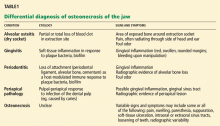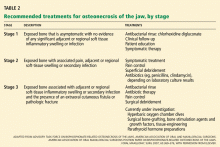Bisphosphonates and osteonecrosis of the jaw: Innocent association or significant risk?
ABSTRACTPublished case series and systematic reviews have documented an association between bisphosphonates and osteonecrosis of the jaw. However, a cause-and-effect relationship has not been established, and most of the reported cases have been in patients with cancer who were receiving much higher doses than those used to treat osteoporosis or Paget disease of bone. The risk, if any, to patients with these latter conditions receiving these drugs appears to be very small.
KEY POINTS
- Recently published data do not support the hypothesis that these drugs cause osteonecrosis of the jaw.
- There is no evidence to support routine dental examinations for all patients before starting bisphosphonate therapy for osteoporosis or Paget disease, but heightened concern seems warranted for cancer patients.
- Clinical experience suggests that dental work by experienced dentists and surgeons can be carried out safely with very little risk to patients taking bisphosphonates.
HOW IS OSTEONECROSIS OF THE JAW DIAGNOSED AND MANAGED?
A working definition of osteonecrosis of the jaw has recently emerged, and it will likely continue to evolve as results of further investigation become available.
A confirmed case is defined as an area of exposed bone in the maxillofacial region that does not heal within 8 weeks after being identified by a health care provider, in a patient who is currently receiving or has been exposed to a bisphosphonate and who has not had radiation therapy to the craniofacial region.14,17 This 8-week duration is consistent with the time frame in which soft tissue would be expected to close and exposed bone would be expected to heal under normal conditions after oral surgery such as dental extraction or a flap elevation procedure.
Patients may have no symptoms at the time of presentation. However, symptoms can include oral or jaw pain, difficulty chewing, evidence of infection, and dental loss. Bone loss is often apparent radiographically, and it may be focal or generalized. Other imaging studies such as cone beam computed tomography provide greater detail on the extent and nature of the lesions, and thus provide a better assessment.
Histologically, there is evidence of necrosis, cell death, and, usually, concomitant infection.9–12,17
Management can be difficult
Osteonecrosis of the jaw can be difficult to manage, and extensive guidelines have been published.14–17 Its treatment is complicated because resection of the necrotic area often only makes the necrotic area bigger. Unlike in osteoradionecrosis, surgical removal of the affected area often results in necrosis at the margins of resected bone. This creates a potential situation of “chasing” affected bone in procedure after procedure, which results in significant morbidity.
A preventive protocol for cancer patients
Most of the cases reported so far have been in cancer patients receiving long-term treatment with potent bisphosphonates in high intravenous doses (12 times the usual dose for osteoporosis) after a mucoperiosteal flap elevation dental procedure (many of which were performed on an emergency basis).9–12,14–20 Authors have thus concluded that a preventive protocol should be followed for all patients being considered for intensive bisphosphonate treatment, similar to that adopted for patients receiving head and neck radiation.
Specifically, all chronic dental and periodontal conditions should be identified and stabilized before starting intensive bisphosphonate therapy. Experts today believe that controlling all chronic dental problems before starting intensive intravenous bisphosphonate therapy may be the best method to avoid dental surgery after bisphosphonate therapy has begun, particularly since the washout period (time to elimination of the drug) for bisphosphonates in alveolar bone is unknown.14–20
Although authors seem to agree that such a preventive protocol is prudent for intensive intravenous therapy, it does not appear to be necessary for patients without cancer.14,17 Indeed, such an approach is impractical, given the huge numbers involved and the lack of evidence to support it.
WHAT ARE BISPHOSPHONATES, AND WHY THE CONCERN?
Bisphosphonates are analogues of pyrophosphates, inorganic compounds developed to remove calcium carbonate from water in industrial pipes and laundry machines. Pyrophosphate use in humans arose from their affinity for calcium phosphate, which proved beneficial in scintigraphic imaging studies and in preventing tartar build-up, resulting in their incorporation into toothpastes. Modifications of the pyrophosphate molecule led to the development of diphosphonate compounds (later known as bisphosphonates), which have gained widespread use in treating a variety of disorders of the skeleton and of calcium metabolism.
These drugs prevent bone resorption by selectively inhibiting osteoclastic activity through several mechanisms (depending on the compound), thus helping prevent bone loss, bone pain, and hypercalcemia in diseases of the skeleton.








